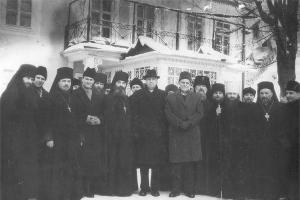This photograph, entitled “View from a Window,” was taken by photography pioneer Joseph Nicéphore Niepce in 1826. The shot was taken from an upstairs window at Niépce's estate in Burgundy, France. The image was produced using a process known as heliography.
 First color photograph created by physicist and mathematician James Clerk Maxwell in 1861. This is a picture of a three-color bow called a Tartan Ribbon (or Tartan Ribbon).
First color photograph created by physicist and mathematician James Clerk Maxwell in 1861. This is a picture of a three-color bow called a Tartan Ribbon (or Tartan Ribbon).
 NASA photographers photographed the first launch at Cape Canaveral in July 1950. The two-stage Bumper 2 rocket you see in the frame contained a V-2 rocket (upper stage) and a WAC Corporal (lower stage).
NASA photographers photographed the first launch at Cape Canaveral in July 1950. The two-stage Bumper 2 rocket you see in the frame contained a V-2 rocket (upper stage) and a WAC Corporal (lower stage).
 The first digital photograph was taken in 1957; almost 20 years before Kodak engineer Steve Sasson invented the first digital camera. This is a digital scan of a photograph originally taken on film. It shows Russell Kirsch's son.
The first digital photograph was taken in 1957; almost 20 years before Kodak engineer Steve Sasson invented the first digital camera. This is a digital scan of a photograph originally taken on film. It shows Russell Kirsch's son.
 The first photograph of a person is considered to be the picture you see above. It was made by Louis Daguerre. The exposure lasted about seven minutes. The shot captures the Boulevard du Temple in Paris. In the lower left corner of the photo you can see a man who stopped to clean his shoes.
The first photograph of a person is considered to be the picture you see above. It was made by Louis Daguerre. The exposure lasted about seven minutes. The shot captures the Boulevard du Temple in Paris. In the lower left corner of the photo you can see a man who stopped to clean his shoes.
 Robert Cornelius set up his camera and took the world's first self-portrait while on Chestnut Street in Philadelphia. He sat in front of the lens for just over a minute before the lens closed. This historical selfie was taken in 1839.
Robert Cornelius set up his camera and took the world's first self-portrait while on Chestnut Street in Philadelphia. He sat in front of the lens for just over a minute before the lens closed. This historical selfie was taken in 1839.
 The first hoax photograph was taken in 1840 by Hippolyte Bayard, who competed with Louis Daguerre in claiming the title of “father of photography.” Bayard was supposedly the first to develop a photographic process, but delayed reporting his achievement. And the efficient Daguerre presented a report on the daguerreotype without mentioning Bayard, who, in despair, made his self-portrait with a regrettable signature. It said that the inconsolable inventor drowned himself.
The first hoax photograph was taken in 1840 by Hippolyte Bayard, who competed with Louis Daguerre in claiming the title of “father of photography.” Bayard was supposedly the first to develop a photographic process, but delayed reporting his achievement. And the efficient Daguerre presented a report on the daguerreotype without mentioning Bayard, who, in despair, made his self-portrait with a regrettable signature. It said that the inconsolable inventor drowned himself.
 The first aerial photograph was taken from a hot air balloon in 1860. It depicts the city of Boston from a height of 610 meters. The photographer, James Wallace Black, titled his work “Boston as Seen by the Eagle and the Wild Goose.”
The first aerial photograph was taken from a hot air balloon in 1860. It depicts the city of Boston from a height of 610 meters. The photographer, James Wallace Black, titled his work “Boston as Seen by the Eagle and the Wild Goose.”
 The first photograph (daguerreotype) of the Sun was taken by French physicists Louis Fizeau and Foucault Leon on April 2, 1845.
The first photograph (daguerreotype) of the Sun was taken by French physicists Louis Fizeau and Foucault Leon on April 2, 1845.
 The first photograph from space was taken from the V-2 rocket, which was launched on October 24, 1946. This is a black and white image of the Earth taken with a 35 mm camera at an altitude of 104.6 km.
The first photograph from space was taken from the V-2 rocket, which was launched on October 24, 1946. This is a black and white image of the Earth taken with a 35 mm camera at an altitude of 104.6 km.
 The photojournalist's name is unknown, but this image, taken in 1847, is considered the first news photograph. It shows a man who was detained by police in France.
The photojournalist's name is unknown, but this image, taken in 1847, is considered the first news photograph. It shows a man who was detained by police in France.
 John Quincy Adams, the sixth President of the United States, became the first head of state to have his photograph taken. The daguerreotype was taken in 1843, many years after Adams left office.
John Quincy Adams, the sixth President of the United States, became the first head of state to have his photograph taken. The daguerreotype was taken in 1843, many years after Adams left office.
 This photograph was taken by photographer William Jennings in 1882.
This photograph was taken by photographer William Jennings in 1882.
 Disasters are not the most pleasant topic, but you can learn from the mistakes of the past. This photo was taken in 1908, when aviator Thomas Selfridge died, becoming the first victim of an air crash.
Disasters are not the most pleasant topic, but you can learn from the mistakes of the past. This photo was taken in 1908, when aviator Thomas Selfridge died, becoming the first victim of an air crash.
 John William Draper was the first to photograph the Moon on March 26, 1840. He obtained the image using daguerreotype from the rooftop observatory at New York University.
John William Draper was the first to photograph the Moon on March 26, 1840. He obtained the image using daguerreotype from the rooftop observatory at New York University.
 The first color landscape, showing the world natural colors, was filmed in 1877. Photographer Louis Arthur Ducos du Hauron, a pioneer of color photography, captured the landscape in the south of France.
The first color landscape, showing the world natural colors, was filmed in 1877. Photographer Louis Arthur Ducos du Hauron, a pioneer of color photography, captured the landscape in the south of France.
 The Earth was photographed from the Moon on August 23, 1966. This image was taken from the Lunar Orbiter traveling in close proximity to the Earth's satellite.
The Earth was photographed from the Moon on August 23, 1966. This image was taken from the Lunar Orbiter traveling in close proximity to the Earth's satellite.
 Nature sometimes demonstrates its enormous destructive force. This image of a tornado was taken in 1884 in Anderson County, Kansas. Amateur photographer A.A. Adams was 22.5 km from the tornado.
Nature sometimes demonstrates its enormous destructive force. This image of a tornado was taken in 1884 in Anderson County, Kansas. Amateur photographer A.A. Adams was 22.5 km from the tornado.
Frames from which the history of photography began
Almost 200 years ago, Frenchman Joseph Nicéphore Niepce smeared a thin layer of asphalt on a metal plate and exposed it to the sun in a camera obscura. This is how he received the world's first “reflection of the visible.” The photo didn't turn out great best quality, but this is where the history of photography begins.
Since then, photography, in addition to turning from black and white to color, has received many more varieties: aerial and space photography, photomontage and x-rays, self-portraiture, underwater photography and 3D photography have appeared. And at the origins of each genre there was a pioneer.
The very first photographs in the history of photography of all these genres are collected in this material. First photo
The very first photo in the world was taken in 1826 by Joseph Nicéphore Niepce. The photo is called “View from the Window”. The photo was taken using a pinhole camera with a tin plate covered with a thin layer of asphalt. The exhibition lasted about 14 hours.
First color photograph
The very first color photo was taken in 1861 by the English physicist James Clerk Maxwell. The photo is called “Tarravel Ribbon”.
2.
First photomontage
In 1858, Henry Peach Robinmon performed the first photomontage, combining several negatives into one image. This is “Fading Away,” a combination of five negatives depicting the death of a girl from tuberculosis.
3.
First photographic portrait
The first photographic portrait in the world is a self-portrait of Robert Cornelius, 1839. After removing the cover from the photographic lens, he rushed into the frame, where he sat for more than a minute until the lens was closed. Words written on the back with my own hand Cornelia, they say: “The first picture in the world ever. 1839 »
4.
First photograph of a person
The first photograph of a person is considered to be “Boulevard du Temple,” a photograph taken by Louis Daguerre at the end of 1838. In the lower left corner you can see the figure of a man whose shoes are being cleaned. He remained motionless long enough to be captured on the photographic plate. The exposure was at least 10 minutes, so the street seems deserted.
5.
The first photo from space
The very first photograph in space was taken on October 24, 1946. The photo was taken from a V-2 rocket using a 35mm camera.
6.
First photograph of the moon
54 years ago, on October 7, 1959, it was photographed for the first time back side Moons. Despite the poor quality, the images provided the USSR with priority in naming objects on the lunar surface.
7.
First aerial photography
The first aerial photography was carried out by the French inventor Gaspard Tournache (Nadar) in 1858. He photographed Paris from a hot air balloon.
8.
First X-ray
The first X-ray photograph was a photograph of the hand of Wilhelm Roentgen's wife, 1895.
9.
First underwater photo
The very first underwater photograph was taken by William Thompson in 1856. During the shooting, the camera was installed on the seabed near Weymont (UK).
10.
First underwater color photograph
The first underwater color photograph was taken in the Gulf of Mexico by Dr. W. Longley Charles Martin in 1926.
11.
The first color photograph of the Earth
One of the most popular photographs of the Earth from space was taken by the Apollo 17 crew on December 7, 1972.
12.
The first photograph of another planet
The image was taken by the Venera 9 spacecraft in 1975.
13.
First amateur photos
125 years ago, in 1888, Kodak launched the world's first amateur camera.
Kodak was sold with a set of 100 negatives. Customers, having clicked all hundred, sent them, along with the camera, back to the Kodak plant to have the photographs developed and produced. The company then sent the client photos and a camera ready to capture 100 more views.
Thousands of photographs passed through the hands of workers at the factory, but they considered it necessary to preserve some scenes from the 1890s for posterity.
14. Children swimming in the sea, 1890. Collection of the Kodak Museum.
15. Woman at a market stall, 1890. Collection of the Kodak Museum.
First 3D photos
In the 1920s, the Cavenders cigarette company was looking for a way to increase sales. To make the packaging more attractive, he turned to fellow photographer Durden Holmes to come up with something eye-catching. The photographer suggested unusual idea: print two pictures next to each other on cigarette packs, one for the left eye, the other for the right. At the same time, the image in one picture was slightly shifted to the side, and when looking at the pictures, a feeling of depth in the photograph was created, a 3D effect.
Today, these pictures have been converted into GIF images and received a real and familiar 3D effect.
16. Billingsgate Fish Market
17. Traffic jam at the Bank of England, London
Now photography is something commonplace for us, but in our beloved 19th century, all this was for the first time.
Here is a small selection of first-of-its-kind photographs in various fields.
The very first photograph - 1826.
The first photograph in history is considered to be “View from a Window,” taken by the Frenchman Joseph Nicéphore Niepce in 1826 using a pinhole camera on a tin plate covered with a thin layer of asphalt. To take the picture, Niépce used an eight-hour shutter speed, placing the camera obscura on the windowsill at country house your family.
The first photograph depicting another person - 1839.
This world's first photograph - "Boulevard du Temple", Paris Boulevard - with the person depicted in it was taken by the Frenchman Louis-Jacques Mande Daguerre (the man who invented the daguerreotype). The photo shows a busy street that appears to be deserted (the exposure is 10 minutes and therefore there is no movement) except for one person in the bottom left of the photo.
The world's first photomontage - 1856
The first combination print was made by the Swede Oscar G. Rejlander. He made a print, measuring 31 by 16 inches, from thirty different negatives. The allegorical photograph “Two Roads of Life” is an ancient saga about the entry into life of two young people.
Reilander's combined photographs, in which composed scenes and contrived poses were shot, were taken from retouched negatives, and additional drawings were made on the negatives necessary details, and unnecessary ones were deleted.
Here I will allow myself to deviate a little from the topic. It was Reilander who studied with the Reverend Charles L. Dodgson, known to us as Lewis Carroll, who subsequently took several unforgettable photographs, among which photographs of children stand out, including, of course, Alice Liddell, the prototype of the book’s character. Here is a photo of her taken by Carroll: 
However, the more famous montage photograph is that taken by Henry Peach Robinson in 1858. - “Dying” (or “Leaving”): an image created using five negatives. 
The photograph shows a young woman dying of consumption.
The first underwater photograph - 1856
The first underwater photographs were taken by William Thompson in 1856, using a camera mounted on the bottom. The photographs contained seaweed, but the photographs themselves were of very poor quality and, unfortunately, all the footage from that year was lost.
But we can look at the photo of the first published underwater photograph of Louis Boutant (c. 1890) and at a wonderful diving suit with a hard helmet: 
First aerial photography - 1858 In 1858, Gaspard Felix Tournachon (better known as Nadar), a cartoonist, novelist and aeronaut, took a camera into the basket of a hot air balloon and took several photographs from above Paris.
In 1858, Gaspard Felix Tournachon (better known as Nadar), a cartoonist, novelist and aeronaut, took a camera into the basket of a hot air balloon and took several photographs from above Paris.
Nadar did not take his photographs from a tripod, as shown in this picture (by Honoré Daumier). He mounted his camera on the edge of the basket or stuck the lens through the bottom. Aerial photographs of Nadar have not survived to this day.
The most early photo, preserved to this day, filmed from the air by James Black in 1860, it depicts the city of Boston: 
The first color photograph - 1861
The author of this photograph is physicist James Clerk Maxwell. He captured the strip of tartan with three different cameras using red, blue and yellow filters, and then combined the images into one color composition.
The first photos of a moving object - 1872-78.

The author of the photographs is Eadweard Muybridge. First successful photographs of a horse moving along a track in Palo Alto, San Francisco, June 19, 1878. Muybridge developed a special apparatus that demonstrated dynamic movement using a significant number of individual photographs. The final impetus for its development was an experiment conducted in 1877. This experiment was initially not of a scientific nature, but just an attempt to resolve a dispute between Governor Leland Stanford, who argued that a horse lifts all 4 legs off the ground while galloping, and his opponent, who insisted that at least one leg when running never leaves the ground. Muybridge placed 12 cameras along the entire route. During the race, the horse came into contact with the floor, the boards of which were connected to the camera shutter. A series of photographs have proven that during a gallop there are moments when all 4 of a horse's hooves hit the ground at the same time.
Muybridge's research and technical inventions subsequently contributed greatly to the invention of cinema.
To prepare the material, various sources were used, including
An exhibition dedicated to the origins of photography has opened at Tate Britain in London. It shows the earliest photographs taken from 1840 to 1860. See on FullPicture the very first photographs in history, which capture the amazing atmosphere and people of those times when the most effective and popular means of transmitting information of our time - photography - was born.
22 PHOTOS
1. Cart. The photograph was taken in Brittany around 1857. Photographer: Paul Mares. (Photo: Wilson Center for Photography)  2. Newhaven Fishermen (Alexander Rutherford, William Ramsay and John Liston), circa 1845. Photography by Hill & Adamson. (Photo: Wilson Center for Photography)
2. Newhaven Fishermen (Alexander Rutherford, William Ramsay and John Liston), circa 1845. Photography by Hill & Adamson. (Photo: Wilson Center for Photography)  3. Mom and son. 1855 Photographer: Jean-Baptiste Frenet. (Photo: Wilson Center for Photography)
3. Mom and son. 1855 Photographer: Jean-Baptiste Frenet. (Photo: Wilson Center for Photography)  4. The Photographer's Daughter, Ela Theresa Talbot, 1843-1844. Photographer: William Fox Talbot. (Photo: Wilson Center for Photography)
4. The Photographer's Daughter, Ela Theresa Talbot, 1843-1844. Photographer: William Fox Talbot. (Photo: Wilson Center for Photography)  5. Horse and groom. 1855 Photographer: Jean-Baptiste Frenet. (Photo: Wilson Center for Photography)
5. Horse and groom. 1855 Photographer: Jean-Baptiste Frenet. (Photo: Wilson Center for Photography)  6. Madame Frenet with her daughters. Circa 1855. Photographer: Jean-Baptiste Frenet. (Photo: Wilson Center for Photography)
6. Madame Frenet with her daughters. Circa 1855. Photographer: Jean-Baptiste Frenet. (Photo: Wilson Center for Photography)  7. Pyramids at Giza. 1857 Photographers: James Robertson and Felice Beato. (Photo: Wilson Center for Photography)
7. Pyramids at Giza. 1857 Photographers: James Robertson and Felice Beato. (Photo: Wilson Center for Photography)  8. Portrait of a woman, taken around 1854. Photographer: Roger Fenton. (Photo: Wilson Center for Photography)
8. Portrait of a woman, taken around 1854. Photographer: Roger Fenton. (Photo: Wilson Center for Photography)  9. Photographer - John Beasly Greene. El Assasif, pink granite gate, Thebes, 1854. (Photo: Wilson Center for Photography)
9. Photographer - John Beasly Greene. El Assasif, pink granite gate, Thebes, 1854. (Photo: Wilson Center for Photography)  10. Construction of Nelson's Column in Trafalgar Square, 1844. Photographer: William Fox Talbot. (Photo: Wilson Center for Photography)
10. Construction of Nelson's Column in Trafalgar Square, 1844. Photographer: William Fox Talbot. (Photo: Wilson Center for Photography)  11. Goods from China, 1844. Photographer: William Fox Talbot. (Photo: Wilson Center for Photography)
11. Goods from China, 1844. Photographer: William Fox Talbot. (Photo: Wilson Center for Photography)  12. Flood in 1856 in the Brotteaux area of Lyon. Photographer: Edouard Denis Baldus. (Photo: Wilson Center for Photography)
12. Flood in 1856 in the Brotteaux area of Lyon. Photographer: Edouard Denis Baldus. (Photo: Wilson Center for Photography)  13. Parthenon at the Acropolis, Athens, 1852. Photographer: Eugene Piot. (Photo: Wilson Center for Photography)
13. Parthenon at the Acropolis, Athens, 1852. Photographer: Eugene Piot. (Photo: Wilson Center for Photography)  14. One of the streets of Paris in 1843. Photographer: William Fox Talbot. (Photo: Wilson Center for Photography)
14. One of the streets of Paris in 1843. Photographer: William Fox Talbot. (Photo: Wilson Center for Photography)  15. Group of Croatian leaders. 1855 Photographer: Roger Fenton. (Photo: Wilson Center for Photography)
15. Group of Croatian leaders. 1855 Photographer: Roger Fenton. (Photo: Wilson Center for Photography)  16. Captain Mottram Andrews, 28th Foot (1st Staffordshire), 1855. Photographer: Roger Fenton. (Photo: Wilson Center for Photography)
16. Captain Mottram Andrews, 28th Foot (1st Staffordshire), 1855. Photographer: Roger Fenton. (Photo: Wilson Center for Photography)  17. Canteen. [A woman who accompanied the army and sold various goods to the soldiers, and also provided services, including sexual ones]. 1855 Photographer: Roger Fenton. (Photo: Wilson Center for Photography)
17. Canteen. [A woman who accompanied the army and sold various goods to the soldiers, and also provided services, including sexual ones]. 1855 Photographer: Roger Fenton. (Photo: Wilson Center for Photography)  18. Five fisherwomen from Newhaven, circa 1844. Photographers: David Hill and Robert Adamson. (Photo: Wilson Center for Photography)
18. Five fisherwomen from Newhaven, circa 1844. Photographers: David Hill and Robert Adamson. (Photo: Wilson Center for Photography)  19. "Fruit sellers." The photograph was most likely taken in September 1845. The author of the photo is most likely Calvert Jones, but it is possible that William Fox Talbot. (Photo: Wilson Center for Photography)
19. "Fruit sellers." The photograph was most likely taken in September 1845. The author of the photo is most likely Calvert Jones, but it is possible that William Fox Talbot. (Photo: Wilson Center for Photography)  20. At the foot of the obelisk (Obelisk of Theodosius in Constantinople), 1855. Photographer: James Robertson. (Photo: Wilson Center for Photography) 22. Daisies (Margaret and Mary Cavendish), circa 1845. Photographers: David Hill and Robert Adamson. (Photo: Wilson Center for Photography)
20. At the foot of the obelisk (Obelisk of Theodosius in Constantinople), 1855. Photographer: James Robertson. (Photo: Wilson Center for Photography) 22. Daisies (Margaret and Mary Cavendish), circa 1845. Photographers: David Hill and Robert Adamson. (Photo: Wilson Center for Photography)
Incredible facts
When we think of old photographs, we primarily think of black and white pictures, but as these stunning photo early 20th century, color photography was much more advanced than one might think.
Before 1907, if you wanted a color photograph, a professional colorist had to color it using different dyes and pigments.
However, two French brothers, Auguste and Louis Lumière, made a splash in the field of photography. Using colored potato starch particles and a light-sensitive emulsion, they could take color photographs without the need for additional coloring.
Despite the difficulty of production, as well as the high cost, the process of producing color photographs was very popular among photographers, and one of the world's first books on color photography was published using this technique.
First color photos
Thus, the brothers revolutionized the world of photography, and Kodak later took photography to a whole new level by introducing Kodakchrome film to the market in 1935. It was an easier and more convenient alternative to the invention of the Lumière brothers. Their Autochrome Lumiere technology immediately became obsolete, but still remained popular in France until the 1950s.
Kodakchrome, in turn, also became obsolete with the advent of digital photography. Kodak stopped producing film in 2009. Digital photography is the most popular form of photography today, but modern advances in photography would not be possible without the hard work of pioneers Auguste and Louis Lumière.
Now let's look at a collection of amazing photographs from a century ago, taken using the innovative technology of the Lumière brothers.
1. Christina in red, 1913

2. Street flower seller, Paris, 1914

3. Heinz and Eva on the Hill, 1925

4. Sisters sitting in the garden making bouquets of roses, 1911

5. Moulin Rouge, Paris, 1914

6. Dreams, 1909

7. Mrs. A. Van Besten, 1910

8. Girl with a doll near soldiers' equipment in Reims, France, 1917

9. Eiffel Tower, Paris, 1914

10. Street in Grenada, 1915

11. One of the very first color photographs, made using the technology of the Lumière brothers, 1907

12. Young girl in daisies, 1912

13. Two girls on the balcony, 1908

14. Balloons, Paris, 1914

15. Charlie Chaplin, 1918

The very first color photographs
16. Mark Twain's Autochrome, 1908

17. Open market, Paris, 1914

18. Christina in red, 1913

19. Woman smoking opium, 1915

20. Two girls in oriental costumes, 1908

21. Van Besten painting in the garden, 1912

22. Bosnia-Herzegovina, 1913

23. Woman and girl in nature, 1910

24. Eva and Heinz on the shore of Lake Lucerne, Switzerland, 1927

25. Mother and daughters in traditional clothes, Sweden, 1910

26. Neptune's Fountain, Cheltenham, 1910

27. Family portrait, Belgium, 1913

28. Girl in the garden with flowers, 1908








